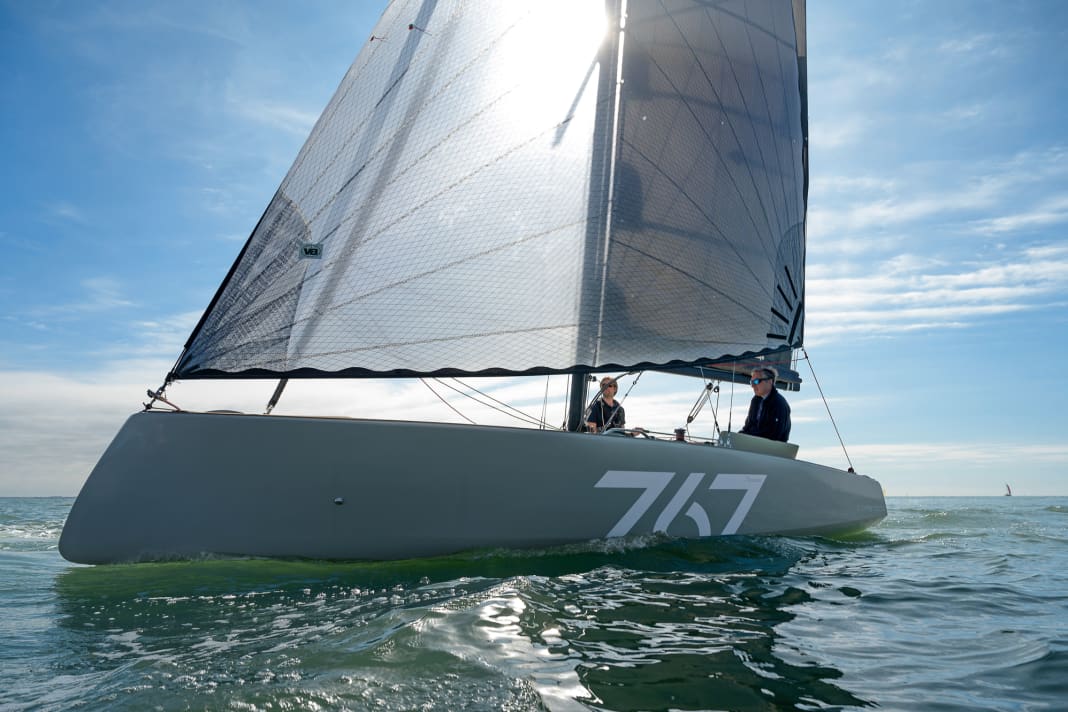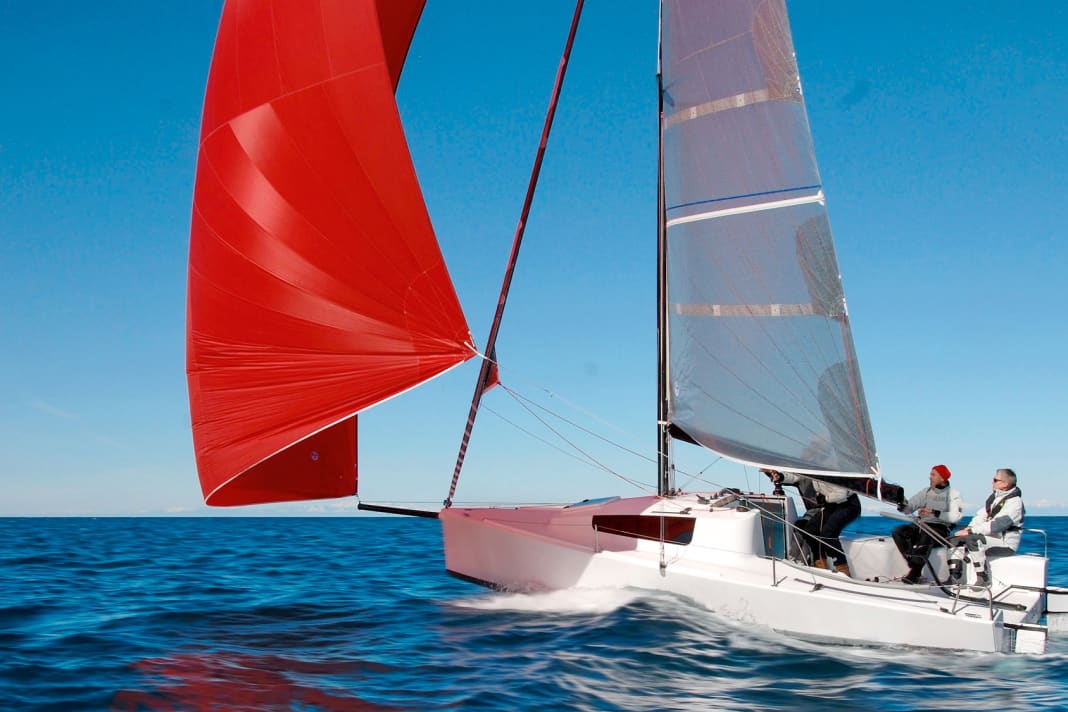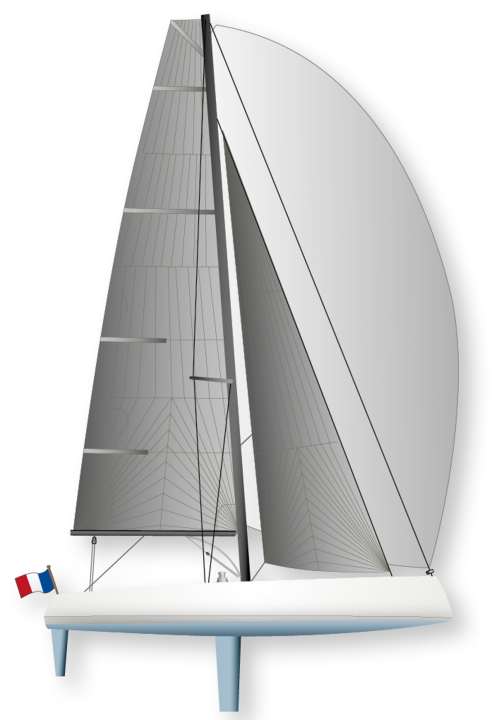





The pleasure of sailing is determined by many factors: Recreation, exercise, variety or simply experiencing nature. Last but not least, the pleasure of water sports in general is enhanced by the attractiveness of a floating vessel. The Cape Cod 767 from France is the kind of boat you want to set sail on at any time - at least as long as you don't want to tackle long distances on the high seas in heavy weather. This boat, which is as exciting as it is versatile, is much more suitable for sporty or relaxed daysailing, as a trailer boat and is even suitable as a small tourer for the weekend.
Rosewest is the name of the small yacht-building company in Bordeaux on the French west coast from which the Cape Cod 767 originates. The shipyard has been on the market for twelve years and already has a very pretty daysailer of almost nine metres in length at the start with the larger Cape Cod 896. 30 ships of this type have already been built. With a smaller reinterpretation of the modern daysailer, the brand now wants to position itself more broadly and also meet the ever-increasing demand for uncomplicated and trailerable boats. With its almost completely retractable integral canting keel, the aft-mounted rudder blade and a width of just 2.54 metres, the Cape Cod 767 is ideally suited for this - even for launching and retrieving via the slip ramp.
The competition: very broadly positioned in this length segment





The Cape Cod 767 sails sleek and remarkably stiff
Hervé Nollet is both the shipyard and brand owner as well as the designer of his boats. Although the two models in the current small series share the same general orientation as daysailers, they are very different in terms of design. While the Cape Cod 896 is designed for an attractive, neoclassical look with a wide overhanging stern, an indented waterline and a pronounced deck sweep, the smaller Cape Cod 767 has an almost completely opposite design approach. The deck of this boat has a conspicuously negative rake, the modern hull shape is set off sharply with striking chine edges, and the sharp canoe bow makes for an exciting look. The boats from the same company could hardly be more different.
The Cape Cod 767 is available to the YACHT editorial team for a test in La Rochelle, where it has to prove itself to the international jury as a nominee for the European Yacht of the Year 2024. The conditions on the test day: light winds of around ten knots (3 Beaufort), hardly any waves and sunshine. Conditions that were tailor-made for the Cape Cod 767. Despite the relatively small self-tacking jib, the boat gets under way quickly and well upwind. The log registers 6.2 knots at a tacking angle of around 90 degrees. That's pretty good performance data for a pure daysailer of this orientation and size.
The boat also sails remarkably stiffly. The wide aft hull with the flat frame and the hard-set chine edges is effective, and the small boat sails beautifully upright even under a lot of pressure. The high dimensional stability is efficiently supported by the swing keel with a draught of 1.80 metres and 350 kilograms of lead ballast at the lower end. The little Frenchwoman also reacts agilely and lively to steering commands. However, the tiller is unnecessarily short. Because the lever is too small, the helmsman has little feeling for the rudder and also needs more strength to work on the tiller or the tiller boom.
High performance potential with room for improvement
A rollable Code Zero (from a wind angle of approx. 60 degrees) or a gennaker (from 90 degrees) can be used for the space wind sections and ensure a good increase in performance. Unlike many sports boats of this type and size, however, the shipyard has dispensed with a fixed or extendable bowsprit. The additional sails are attached directly to the bow as an extension of the negative stem. The forestay of the jib is set relatively far back so that jibing with Code Zero and a gennaker works smoothly. However, because the mast is also positioned far aft, roughly in the centre, the upwind sail plan is high and slender, but still reasonably dimensioned. The sail carrying capacity of 5.2 also represents a high performance potential.
The test boat, construction number one from Rosewest, has a comparatively high mast made of a robust, relatively thick and completely untapered aluminium profile with a pair of spreaders. A backstay is not provided, but a sporty mainsail with a widely flared head (squarehead) can be set. However, the extremely rigid mast is almost untrimmable in the test and is therefore to be replaced by a thinner, more flexible and also less heavy profile from the manufacturer AG+ as standard for the following construction numbers.
Sporty sailors can have their Cape Cod 767 optionally equipped with an even lighter carbon fibre mast and even with two harnesses for more fun and performance. However, the weight of the rig is not only an issue in terms of performance. The mast is mounted in a folding foot at the level of the cockpit floor and can be easily set and lowered by hand. The lighter the profile, the easier it is to handle.
In the cockpit of the Cape Cod 767
The cockpit is very spacious and offers plenty of room for up to six fellow sailors. Thanks to the extremely simple layout on deck and the self-tacking jib, soloists in single-handed operation also have an easy time handling the boat, even in stronger winds. The trimming equipment is clearly arranged and easy to reach. Ambitious sailors would want a traveller on the rear cockpit floor for the high and slim mainsail with squarehead, but the shipyard does not offer this as an option. Instead of this trimming instrument, a simple bulkhead buoy is supplied, with which the main boom can be trimmed to windward - a simple and equally effective device, even if shackling the sail after the manoeuvre requires further manual action.
If there is no wind, the Cape Cod 767 can be propelled by an outboard motor (electric or petrol). When not in use, the whisk is stored in a sealed storage compartment in the stern. The shipyard has invented an excellently functioning mechanism for this purpose, which allows the engine to be folded out and reinstalled with a flick of the wrist. All motorisation variants are optional and incur corresponding surcharges.
Fresh ideas that come at a price
A big surprise awaits in the completely enclosed foredeck, where two berths are installed lengthways. A large hatch cover in the foredeck provides access to the slip cabin, where two people can lie down and spend the night with limited comfort if necessary. The interior is not cosy and there are no windows or ventilation options.
The Cape Cod 767 is exceptional and packed with all kinds of fresh, good ideas. However, the joy of the boat is dampened by the high basic price of around 130,000 euros. This is a lot of money for a small boat of this size, orientation and design, even if the shipyard delivers it largely ready to sail, i.e. including the sails (main, jib, code zero) and a deck covering with imitation teak.
It remains to be seen whether the small, smart Frenchwoman can stand up to the strong competition from Tofinou, Saffier or Sunbeam, for example. Apart from the price, it certainly has what it takes.
The measured values for the test of the Cape Cod 767



The Cape Cod 767 in detail

Technical data of the Cape Cod 767
- Designer: Hervé Nollet
- CE design category: C
- Torso length: 7,67 m
- Total length: 7,67 m
- Waterline length: 7,22 m
- Width: 2,54 m
- Draught Swivelling keel: 0,22-1,80 m
- Mast height above WL: 11,50 m
- Theoretical torso speed: 6.5 kn
- Weight: 1,25 t
- Ballast/proportion: 350 kg/28 %
- Mainsail: 20,4 m²
- Self-tacking jib: 11,5 m²
- Code Zero: 23,0 m²
- Gennaker: 55,5 m²
- Machine (outboard): 5 HP
Hull and deck construction
Hull: GRP sandwich laminate with foam core, built using the vacuum infusion process with epoxy resin
Rig and sail
Aluminium rig from the manufacturer AG+. A carbon fibre mast is available as an option for an additional charge. The mainsail, the self-tacking jib and a rollable code zero are part of the basic equipment
Motorisation
Optional retractable outboard motor (electric or petrol) with storage compartment at the stern or small built-in motor possible. All drive types available as an option at an extra charge
Fuselage attachments
Hydraulic integral swivelling keel with cast iron shaft and lead ballast. Recoverable rudder blade
Equipment and prices
- Base price ex shipyard: 130.300 €
- Price ready to sail: 133.360 €
- Guarantee/against osmosis: 2/2 years
Shipyard and distribution
Rosewest Construction Navale, 33300 Bordeaux (France); www.rosewest.fr
YACHT review of the Cape Cod 767
Pretty daysailer with exciting modern design features. The trailerable boat shows great sailing characteristics in the test. However, the high price is a disappointment
Design and concept
- + Versatile in use
- + Well thought-out layout
- - High price
Sailing performance and trim
- + Sails stiffly on the wind
- + Very easy handling
- - Little steering feel
Living and finishing quality
- + Unexpected housing offer
- + Storage space for chemical WC
- - Narrow bunks
Equipment and technology
- + Swivelling keel as standard
- + High-quality deck equipment
- - No bowsprit

